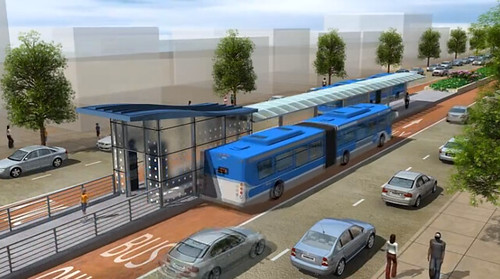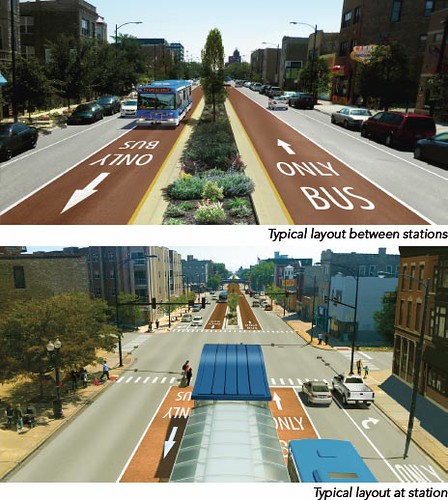
Last time I tried to attend a meeting of the anti-bus rapid transit group the Ashland-Western Coalition, I was invited to leave. When Ashland Avenue corridor resident Lindsay Banks showed up for a recent meeting with a friend, coalition leader Roger Romanelli recognized Banks as a BRT supporter and allowed the pair to stay for a while. However, after Banks was told the meeting was over, the rest of the attendees stuck around, which is when the real meeting apparently took place.
When Andrew Herman, an insurance company employee who lives in the Loop, dropped by last Friday’s coalition meeting at the First Baptist Congregational Church, 1613 West Washington, he says he was allowed to attend the full meeting, and the members were cordial. “I’ve been reading about the group on Streetsblog,” he told me. “I get around mostly without a car, so I thought it would be a good idea to show up for a meeting about the BRT proposal. Better transit is something that would benefit my daily life.”
The small gathering included Romanelli, who also works as the executive director of the Randolph/Fulton Market Association, Jack Rickard, owner of Rickard Bindery, 325 North Ashland, church member Mary Brown, plus a reporter from DNAinfo. The members told Herman they were concerned about the conversion of car lanes to bus lanes and the prohibition of most left turns. Herman was told the travel lane conversion would lead to 30 percent of the car traffic on Ashland being diverted onto side streets, although the members didn’t say where they got that statistic from.
“They said there’s too much traffic in the area during church and United Center events, which seems to me like a good argument for BRT,” Herman said. The members said they had no idea how many people drive versus take transit to the church.
Romanelli said the AWC objects to the cost of the Ashland BRT, estimated at $60 million for the first 5.4-mile phase between 31st Street and Cortland Street, and $160 million for the entire 16-mile route, not including the purchase of left-boarding buses, which would be paid for by CTA's regular bus procurement funds. The coalition has floated a "Modern Express Bus" counter-proposal, which would include numerous infrastructure improvements and the hiring of onboard "bus marshals," but would likely travel slower than the old, slow #X9 Ashland Express buses. "I asked if they have a cost estimate for their plan and they said they had no idea," Herman said.
The AWC members told Herman they want to see the numbers behind the CTA plan, including economic impact and traffic studies, a timeline for the project, and ridership projections. According to the CTA’s Joe Iacobucci, the agency plans to release an environmental assessment of the plan later this month. Depending on the availability of federal funding, construction on the first phase could start as early as 2015 with service launching by the end of the year or in early 2016. The agency predicts that bus ridership will increase by 46 percent to make up 26 percent of all trips on Ashland.
“They kept saying that they felt like they weren’t included in the decision making process,” Herman said. However, several businesses and organizations in the coalition, including the RFMA and the bindery, were involved in area design meetings with the CTA as part of a block-by-block analysis of Ashland in June and July. The agency is holding several public input meetings this fall.
According to Herman, Rickard said the coalition gave a copy of their MEB proposal to 27th Ward Alderman Walter Burnett to submit to the CTA, and claimed the alderman has repeatedly said he doesn’t support the BRT plan but has not come out publicly against it for political reasons.
Romanelli told Herman that the AWC has a list of many businesses that are opposed to BRT. However, he didn’t want to share the names of the businesses because he said they are skittish about being named, for fear that they will be boycotted or protested if they come out publicly as being against the plan.
Herman says Romanelli brought up Streetsblog Chicago three or four times during the meeting, characterizing Streetsblog as “radical bike people” who are making personal attacks on the coalition. Romanelli objects to our use of the term NIMBY (“Not In My Back Yard”) to describe the group and its members. But NIMBY is a fitting label since Romanelli has said that he is fine with BRT, just not on Ashland.
Herman told me more about why he supports the CTA’s plan for fast, reliable BRT service on Ashland. “I have a car, but I believe this solution will help everyone get around better, whether they’re walking, biking, taking transit or driving," he said. "It’s not just for people who don’t drive.”

He moved to Chicago from New York City, where he lived at First Avenue and 14th Street. “I thought it was weird when they started putting in the Select Bus Service on First Avenue,” he said. “They took out car lanes and put in a bus lane and a protected bike lane. But afterwards I found I got to work faster. They put in pedestrian islands so it was easier to cross the street. Reconfiguring the street calmed traffic and make it more organized. I don’t think it caused more congestion. Traffic seems to flow at the same speed, or maybe a little faster.” GPS data from NYC cabs shows that, in fact, the average traffic speed increased after Select Bus Service was implemented.
At the coalition meeting, Romanelli told Herman that the success of Select Bus Service in New York and Cleveland’s Health Line BRT service are not comparable to Chicago. “Every example you give, they say Chicago is different,” Herman said. “But after seeing what New York has done in terms of being more walking, biking, and transit-friendly, I think Chicago has the opportunity to do the same thing.”
The Ashland-Western Coalition is about to get its first exposure in the daily papers. This morning about a dozen members, including Romanelli and Rickard, showed up for a photo op and interview session at Orlando Glass and Trim, 641 North Ashland, with Sun-Times transportation reporter Rosalind Rossi. We’ll provide our take on Rossi’s article when it comes out later this week.






